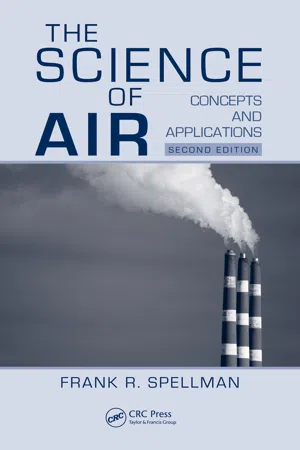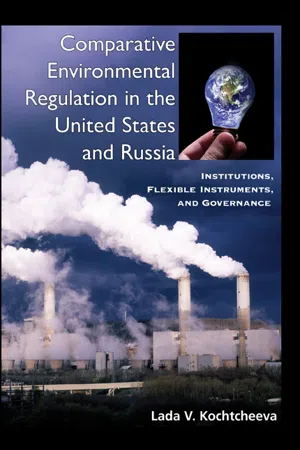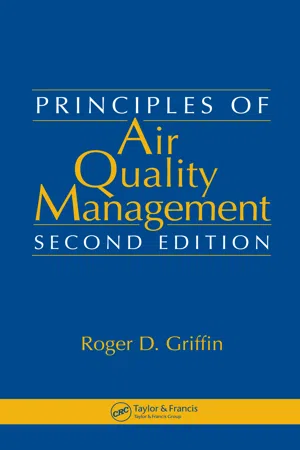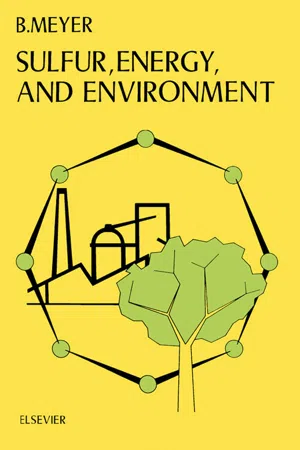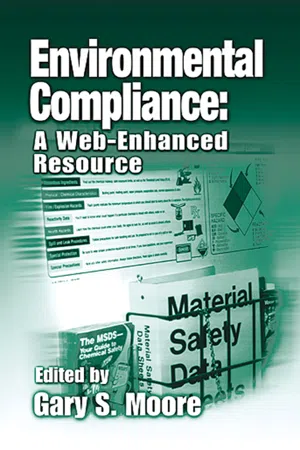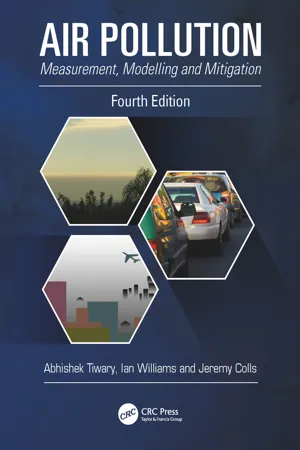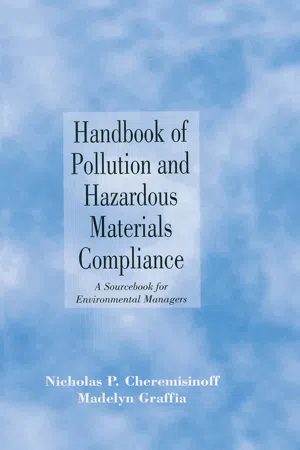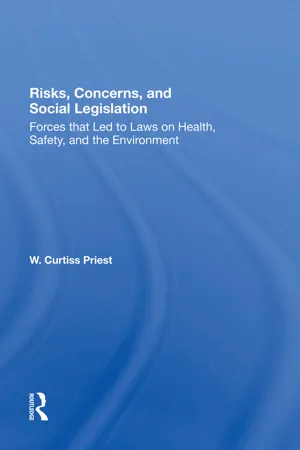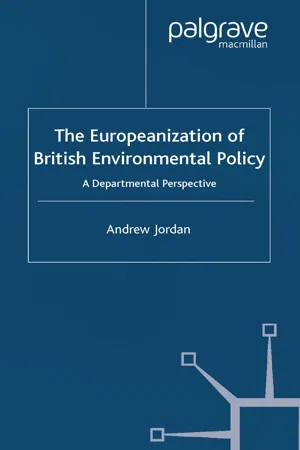History
Air Quality Legislation
Air quality legislation refers to laws and regulations aimed at protecting and improving the quality of the air we breathe. These measures typically set limits on pollutants emitted by industrial processes, vehicles, and other sources, and establish standards for air quality. Over time, air quality legislation has evolved to address new environmental challenges and scientific understanding of air pollution.
Written by Perlego with AI-assistance
Related key terms
1 of 5
10 Key excerpts on "Air Quality Legislation"
- eBook - PDF
The Science of Air
Concepts and Applications, Second Edition
- Frank R. Spellman(Author)
- 2016(Publication Date)
- CRC Press(Publisher)
We have found that we must concern ourselves not only with ambient air quality in our local outdoor envi-ronment, but also with the issue of indoor air quality. To accomplish air quality management, we have found that managing is one thing—and accomplishing significant change improvement is another. We need to add regulatory authority, regulations, and regulatory enforcement authority to the air quality management scheme; strictly voluntary compliance is ineffective. We cannot maintain a quality air supply without proper management, regula-tion, and regulatory enforcement. This chapter presents the regulatory framework governing air quality management. It provides an overview of the environmental air quality laws and regulations used to protect human health and the environment from the potential hazards of air pollution. New legislation, reauthorizations of acts, and 182 The Science of Air: Concepts and Applications new National Ambient Air Quality Standards (NAAQS) have created many changes in the way both government and industry manage their business. Fortunately, for our environment and for us, they are management tools that are effective—they are working to manage air quality. CLEAN AIR ACT (CAA) When you look at a historical overview of air quality regulations, you might be sur-prised to discover that most air quality regulations are recent. For example, in the United States the first attempt at regulating air quality came about through passage of the Air Pollution Control Act of 1955 (Public Law 84-159). This act was a step forward, but that’s about all; it did little more than move us toward effective legisla-tion. Revised in 1960 and again in 1962, the act was supplanted by the Clean Air Act (CAA) of 1963 (Public Law 88-206). CAA 1963 encouraged state, local, and regional programs for air pollution control but reserved the right of federal inter-vention, should pollution from one state endanger the health and welfare of citizens residing in another state. - eBook - PDF
Comparative Environmental Regulation in the United States and Russia
Institutions, Flexible Instruments, and Governance
- Lada V. Kochtcheeva(Author)
- 2008(Publication Date)
- SUNY Press(Publisher)
POLICY LAUNCH: CONGRESSIONAL INTEREST AND STATE RESPONSIBILITY National concern with air pollution in the United States started as early as 1955, when Congress offered financial and technical assistance to the states through the Air Pollution Control Act (Smith 2004). Table 3.2 demonstrates the development of air pollution control legislation in the United States. While the states were responsible for regulating air qual- ity, the law authorized $5 million annually to the Public Health Service for research and technical assistance to the states (U.S. Congress, Senate 1970b, 249). Continued pressure by the states’ delegations and the evidence provided by federal reports on air pollution problems generated an incen- tive for further federal action (Bailey 1998). The Clean Air Act (CAA) of 1963 became another effort to legislate air pollution control (Crandall 1983; Portney 2000). The act authorized the Secretary of the Department of Health, Education and Welfare (HEW) to take legal action against pol- luters causing interstate pollution. A belief that air pollution control was the constitutional prerogative of the states and local governments, however, restricted the options available to policy makers. The Public Health Service authorized with research responsibilities felt that “regulatory authority would threaten its reputation as an apolitical, highly professional, research-oriented organization” (Bailey 1998, 101). Between 1965 and 1970, only eleven abatement actions had been initi- ated under the 1963 CAA at the federal level (Rosenbaum 1973). To improve the apparatus for enforcing pollution abatement, Congress passed the Air Quality Act in 1967. This act directed the Secretary of the HEW to establish Air Quality Control Regions and ambient air criteria, where the states would establish emission standards, based on these criteria (Krier 1971). - eBook - PDF
- Roger D. Griffin(Author)
- 2016(Publication Date)
- CRC Press(Publisher)
As a consequence, many of these departments have a long history of air monitoring, regulations, emission standards, local enforcement, and permitting. In general, the regional or local air pollution authorities carry the burden of day-to-day activities with respect to implementation of air quality legislative mandates and regulatory requirements of both federal and state agencies. Municipalities may also implement their own ordinances governing emissions of air contaminants within their jurisdiction, provided they are not preempted by or in conflict with other levels of government. For example, before the 1990 Clean Air Act Amendments, some cities adopted local ordinances that banned emissions, or even the use, of chlorofluorocarbons (CFCs). Frequently, the local governments that have demonstrated the most environmental involvement are located in air pollution– affected areas. However, the fact remains that every level of government may be involved in air quality management to a greater or lesser degree. FEDERAL LAWS AFFECTING AIR QUALITY MANAGEMENT There are a number of laws that affect our approaches to air quality management. They include those that are media specific (water, solid waste) or that have an air quality component (toxic substances, nuclear materials). The former deal with some other aspects of environmental contamination that may have an effect on some aspect of air quality. The Clean Air Act and its predecessors are the most direct federal laws affecting air quality management. P RE -1990 A IR Q UALITY A CTS AND E FFECTS Before the formation of the EPA in 1970, a number of federal laws dealt with air quality. These laws primarily dealt with the criteria pollutants but did make attempts to address noncriteria air contaminant issues. A number of these major concepts were modified and incorporated into the most recent amendments to the Clean Air Act. - eBook - ePub
- Beat Meyer(Author)
- 2013(Publication Date)
- Elsevier(Publisher)
The first step toward the present amendment was the Air Pollution Control Act of 1955, which confines the Federal role to research, and delegates control to the states. This delegation has been significantly diminished with the most recent three revisions. Specific and local problems were to be investigated by the Surgeon General, but only upon request of state or local government. The Clean Air Act of 1963 expanded the research and development scope, and established that, in cases involving interstate pollution, Federal intervention was no longer dependent upon requests from states. In these cases, a conference would be called to deal with the problem. In the following 8 years, nine conferences were called. Of these, only one case survived, and it was settled out of court. The 1963 Act also established air quality criteria, based on scientific knowledge of pollution’s effects. Its declared goal was “to achieve the prevention and control of air pollution,” but legally trained readers noted that neither the scope nor the extent of the problem were spelled out anywhere in the text. The Air Quality Act of 1967 established atmospheric areas and air quality control regions. The contiguous U.S. was divided into 8 atmospheric areas; Alaska and Hawaii each formed an additional area. Since then, some 247 air quality control regions have been defined within these areas, their boundaries being determined by climate, meteorology, and topography. This Act also established air quality criteria, advocated the development of control techniques and reports, and urged states to adopt ambient air quality standards within the control regions. The word “ambient” is of significance. For scientists this term is well defined. It refers to open, freely moving air which can be sampled and quantitatively tested. For lawyers, it refers to the atmosphere above a community in general, without reference to origin, boundary, types or number of emission sources - eBook - PDF
Environmental Compliance
A Web-Enhanced Resource
- Gary S. Moore(Author)
- 2000(Publication Date)
- CRC Press(Publisher)
Nitrogen dioxide irritates lung tissues and reduces resistance to respiratory infections, while possibly increasing the incidence of acute respiratory disease in children. 13 THE HISTORY OF AIR POLLUTION CONTROL IN THE U.S. The control of air pollution was seen as a local control issue up until the 1950s when a federal role began to evolve. It was in 1955 that Congress authorized the Public Health Service in the Department of Health, Education, and Welfare (DHEW) to research air pollution and conduct training programs. However, air quality continued to grow worse and Congress passed the Clean Air Act of 1963, which gave federal author-ity to (1) develop air quality criteria for protecting the public health; (2) conduct research on sulfur dioxide pollution; (3) provide grants to establish state air pollution control agencies; and (4) provide more research, training, and technical assistance with regard to air pollution. Amendments to this Act in 1965 established the National Air Pollution Control Agency (NAPCA), and set emission standards for 1968 model light-auto motor vehicles. In spite of these regulatory initiatives, air pollution continued to worsen, and the 1963 Clear Air Act proved inadequate to deal with the problem. The response of Congress was to pass the Comprehensive Air Quality Act of 1967 which represented the first attempt to develop a regional approach for the control of air pollu-tion through the designation of Air Quality Control Regions (AQCRs). However, states still kept the main responsibility for enforcement and were expected to develop air qual-ity standards and plans for implementing them. Progress proved to be slow, and as the Americans celebrated “Earth Day” for the first time on April 22, 1970, public attention to environmental concerns reached a high level, stimulating Congress to strengthen air pollution control initiatives. - eBook - ePub
Air Pollution
Measurement, Modelling and Mitigation, Fourth Edition
- Abhishek Tiwary, Ian Williams(Authors)
- 2018(Publication Date)
- CRC Press(Publisher)
Chapter 14 Air quality standards and legislations 14.1 WHY DO WE NEED AIR QUALITY STANDARDS?Air quality standards are emission rates or concentrations or deposition rates that are designed to protect people and the environment from harm. The Earth’s atmosphere is one of the global commons – those regions, which also include Antarctica, the ocean floor and outer space, over which no one nation has individual control. There is clear distinction between airspace, which is the 3D volume extending from the surface of a nation up to the top of the atmosphere, and the air that flows through it. Although each nation has sole responsibility for its own airspace, it has joint responsibility for the air within it.A variety of different philosophies has been used to control air pollution. They fall into three general categories. Historically, the philosophy has focused on emissions standards, the assumption being that if we set appropriate maximum emission concentrations, then ambient concentration targets can be achieved. In Europe and the United States, legislation has been framed in terms of air quality standards (AQS) – potential new emitters have to show that their emissions will not cause AQS to be exceeded. On a larger scale, the critical loads and levels approach (see Chapter 10 ) is a more recent concept that relates the maximum deposition fluxes of gaseous and liquid pollutants to their effects on local ecosystems. The concept depends on sophisticated dispersion modelling to calculate the maximum emissions that can be accepted if critical loads and levels at a given receptor site are not to be exceeded.There is a common thread to these ideas. It is assumed that exposure to a pollutant stresses an organism, and that the organism’s natural repair processes can make good any damage provided that the exposure does not rise above some threshold value. This threshold value, sometimes divided by some arbitrary safety - eBook - PDF
Handbook of Pollution and Hazardous Materials Compliance
A Sourcebook for Environmental Managers
- Nicholas P. Cheremisinoff, Madelyn Graffia(Authors)
- 1996(Publication Date)
- CRC Press(Publisher)
Unfortunately, these ordinances and accompanying air quality control efforts had limited success in 71 72 Chapter 3 controlling smoke problems. By the late 1930s and early 1940s air pollution became more severe and cities such as Pittsburgh and St.Louis enacted tougher smoke ordinances providing more effective enforcement, thereby abating smoke problems significantly in those cities. Until the 1950s, however, when the Clean Air legislation was passed, there was no federal involvement in air pollution control. Air pollution control was for the most part a local responsibility. Federal air pollution legislation was enacted in 1955, authorizing the Public Health Service in the Department of Health, Education, and Welfare to perform air pollution research and training programs, and to provide technical assistance to state and local governments. This legislation affirmed that state and local governments had the primary responsibility for air pollution control. Amendments to this law in 1960 and 1962 called for special studies relating to health effects from motor vehicle emissions. The nation's first Clean Air Act (CAA), modest in scope and limited in effect, was enacted in 1963 due to the further deterioration of the nation's air quality. In the initial statute, Congress provided very little federal authority by assigning the federal government a mostly advisory role in air protection efforts such as: preparing air quality reports, identifying the health effects of pollutants, and issuing guidance emission control technologies. Specifically, it provided for: 1. Awarding grants for program development and improvement of state and local air pollution control agencies. 2. Accelerated research, training, and technical assistance. 3. Federal enforcement authority to abate interstate air pollution problems. 4. Federal research responsibility for automobile and sulfur oxides pollution. 5. Air quality criteria development for the protection of public health and welfare. - eBook - ePub
Risks, Concerns, And Social Legislation
Forces That Led To Laws On Health, Safety, And The Environment
- W. Curtiss Priest(Author)
- 2019(Publication Date)
- Routledge(Publisher)
Following the Clean Air Act Amendments of 1970, there was a dramatic increase (nearly double that of the 1960s) in concerns expressed in the popular literature. Three aspects of this period distinguish it from earlier times. First, it now was accepted that the federal government should control air pollution. Second, pollution was identified not as a nuisance to be "absorbed" by the air but as something that "degraded the environment". Accordingly and third, air pollution had become a major political issue as part of what Ralph Nader referred to as 'the environmental bandwagon.' President Nixon reaffirmed the importance of the issue when he proposed a new strict air pollution bill early in 1970.By 1970 the scientific community, the populace at large, and both the executive and legislative branches of the federal government seemed to agree that strict federal control of air pollution was needed and debate shifted to the appropriate means. By the end of 1970, executive and legislative efforts were coordinated. Strict federal air pollution control measures became law and were implemented by the newly formed Environmental Protection Agency.2.3 Historical Review of Forces Leading to Aviation Safety Legislation
2.3.1 Historical Context from the Secondary Literature and Interviews (Aviation Safety)
As a transportation industry, aviation in the United States has been regulated and encouraged by the government almost since its inception early in the twentieth century. Early regulations served to speed industry growth; the rapid expansion of air traffic made them essential for safety as well.World War I occasioned the first mass production of aircraft and pilots, resources which catalyzed commercial air travel. The federal government provided the first commercial use when the Post Office Department established a regular airmail service (staffed by army pilots) even before the war ended [Burkhardt, 1967]. At this time, the Post Office completely controlled airmail service: it owned the planes, hired the pilots, and, by 1924, ran regularly scheduled transcontinental flights. The success of airmail service proved the airplane's economic value and inaugurated commercial aviation. - eBook - PDF
The Europeanization of British Environmental Policy
A Departmental Perspective
- A. Jordan(Author)
- 2002(Publication Date)
- Palgrave Macmillan(Publisher)
The responsibility for addressing less polluting emissions such as grit, smoke and dust continues to lie with local environmental health officers, who use various statutory (the Clean Air Acts) and non-statutory tools to improve urban pollution. Under the Clean Air Acts, local authorities had the power to issue ‘smoke control orders’ prohibiting the emission of smoke from build- ings. The whole system was highly localized insofar as the SoSE had no general power either to set emission standards for the most polluting substances or to set local AQSs for the lesser polluting ones. These diverse elements were underpinned by a policy paradigm which suggest- ed that regulators should concentrate upon minimizing the known effects of pollutants after they had entered the environment, rather than eliminating all emissions regardless of their impact. In effect, scientific proof of actual damage done to the environment (but especially human health) was deemed to be the sine qua non of effective pollution control. This ‘contextual’ approach (which also underpinned British water poli- cy) to dealing with pollution, was staunchly defended by the scientific and political establishment in Britain, including the RCEP and the high- ly respected House of Lords Select Committee on the European Com- munities. The Air Quality Standards Directive The origins of EU policy Sulphur dioxide was listed as a ‘first category’ pollutant in the First Environmental Action Programme. In 1973, the Commission’s social policy Directorate (then DG V 1 ) responded to this obligation by estab- lishing a working group of national experts to develop a proposal to limit atmospheric concentrations. The DoE sent Professor Lawther to represent Britain in the Commission’s working group. On paper, Lawther was a potentially powerful advocate of national policy, because he had Air Policy 153 recently drafted WHO guidelines on sulphur dioxide which the Com- mission was expected to take as its point of departure. - eBook - PDF
Environmental Law in Scotland
An Introduction and Guide
- Francis McManus(Author)
- 2016(Publication Date)
- Edinburgh University Press(Publisher)
The most innovatory provisions of the Act were those relating to the creation of smoke control areas and these had a profound effect on the condition of the atmosphere, especially in urban areas. The 1956 Act can rightly be regarded as a world ‘first’. Indeed, in 1990, the UK government noted, with no little satisfaction, that both the 1956 and 1968 Acts had prevented many thousands of deaths from bronchial illness and had changed our cities for the cleaner and better. 137 The Clean Air Act concept had been adopted by many other countries and had laid the basis for air quality standards which had been set by the European Union . Ambient air quality We now examine how ambient air quality is regulated in Scotland. We look, first, at the European Union (EU) which has become the main driver, in terms of the regulation of ambient air pollution, and, second, at Scotland. The European Union and ambient air pollution The EU was a relative latecomer in terms of addressing the subject of ambient air pollution. 138 Its first actions to deal with air pollution were lim-ited to specific pollution sources, in particular, to emissions from passenger cars. 139 Kramer argues that the real catalyst for change was the concern of governments in central Europe, especially in Germany, in the early 1980s about the effect of air pollution on rain forests. 140 The Directive on Air Quality Limit Values and Guide Values for Sulphur Dioxide and suspended Particulates 141 was the first piece of legislation to lay down man-datory air quality standards. Haigh observes that the Directive brought about a turning-point in British air pollution policy. 142 Notwithstanding the fact that, whilst the EU was a relative latecomer in the field of regulat-ing ambient air pollution, EU air quality policy is now largely driven by concerns about the effect of poor quality air on human health. 143 Currently, at EU level, the main components of EU air quality policy comprise: 1.
Index pages curate the most relevant extracts from our library of academic textbooks. They’ve been created using an in-house natural language model (NLM), each adding context and meaning to key research topics.
